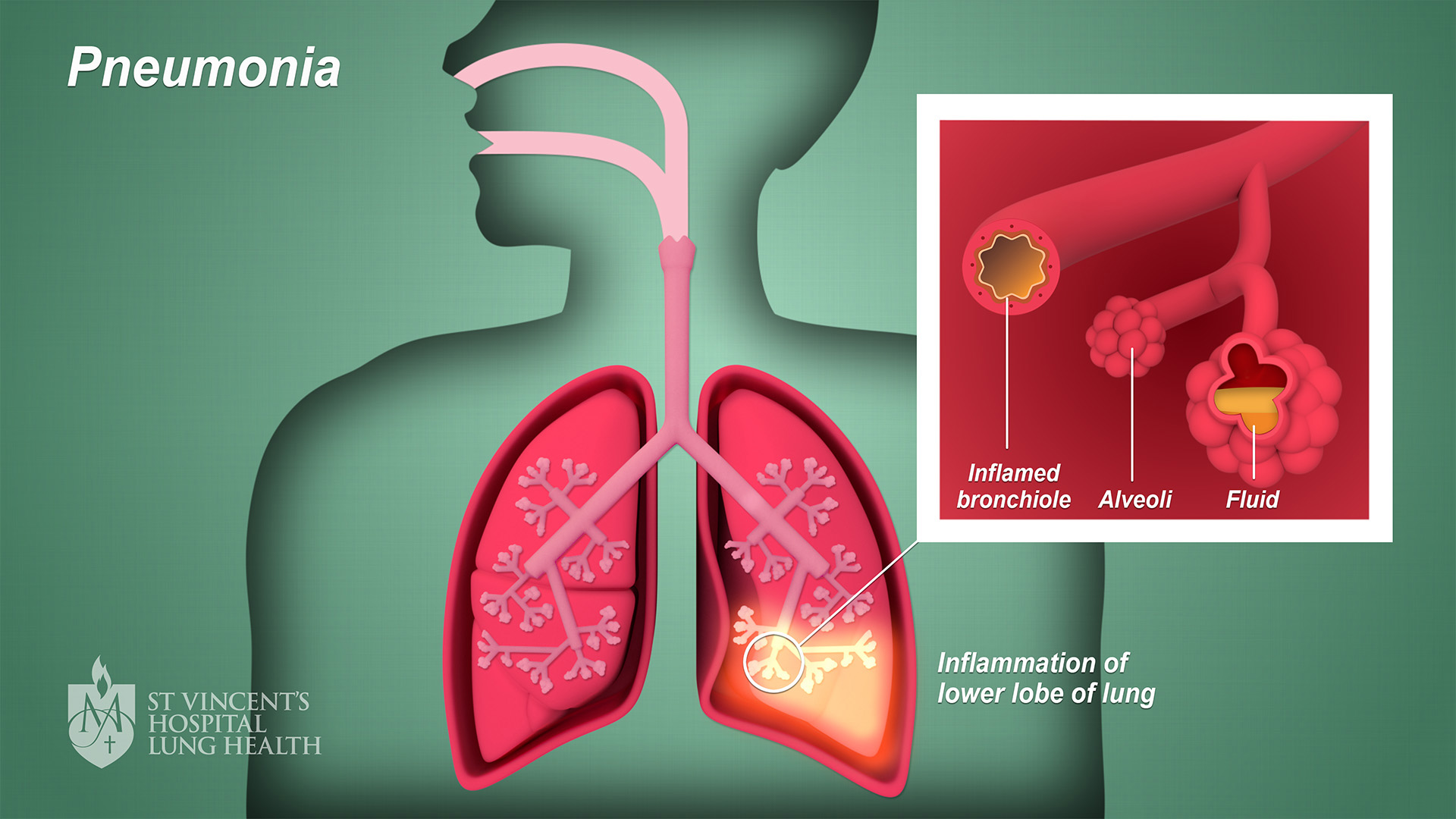Pneumonia
Pneumonia is an infection of your lungs. The infection can range from mild to severe.
What is pneumonia?
What are the causes of pneumonia?
Where does pneumonia come from?
What are the signs and symptoms of pneumonia?
What are the possible tests to diagnose pneumonia?
What are the possible procedures and treatments for pneumonia?
What is the future plan if you have pneumonia?
What is pneumonia?
Pneumonia results from an infection which causes the air sacs (alveoli) in the lungs to become filled with fluid or pus. Pneumonia can develop in either one or both of your lungs.
Anyone can develop pneumonia, although those who are under 2 years or over 65 are more at risk due to a lowered immunity (ability to fight infection).
The image below illustrates pneumonia. (Click image to enlarge)

What are the causes of pneumonia?
Pneumonia can be spread from breathing in infected air droplets from another person’s cough or sneeze.Infectious micro-organisms, or germs cause pneumonia. The main types of these organisms are:
- Bacteria – the most common causes of bacterial pneumonia are Strep. Pneumoniae, Legionella pneumophila and Haemophilus influenza; these may cause a severe infection in part of the lung, may be more widespread across the lungs and often follow a cold or flu-like illness
- Bacteria-like organisms – these organisms may cause a milder pneumonia than bacterial pneumonia; causes include Mycoplasma pneumoniae and Chlamydia pneumoniae
- Fungi – fungal organisms, which can come from the environment, are uncommon causes of pneumonia in otherwise healthy people; usually, fungal pneumonia occurs in people with an immune system problem or previous lung damage from another disease
- Viruses – a common cause of pneumonia which may be more mild than bacterial pneumonia; the influenza virus is one of the main causes of viral pneumonia.
Where does pneumonia come from?
Pneumonia is categorised by whether it developed outside hospital in the community (community-acquired pneumonia) or in hospital (hospital-acquired pneumonia). This is because the organisms that cause it may be different.
Aspiration pneumonia, a different category, is when swallowing is affected and food or drink enter the lung (usually due to illness such as stroke or problems with damaged teeth).
What are the signs and symptoms of pneumonia?
Pneumonia causes flu-like symptoms, which include:
- A dry cough
- Chills
- High fever (above 38°C)
- Feelings of weakness and extreme tiredness
- Loss of appetite
- Severe aches and pains, particularly in the head, lower back and legs.
Symptoms of the flu typically last a few days up to a week. With pneumonia you might have all the symptoms of the flu, but also have:
- A cough with mucus (colour of mucus may vary from yellow to green or with blood)
- Blueish tinge to lips and fingernails
- Confusion (in the elderly)
- Extreme chills that make you shiver
- Extreme tiredness
- Feeling of breathlessness, particularly with movement
- High fever up to 40.5°C
- Loss of appetite
- Rapid heart rate and breathing
- Sharp chest pains which increase in pain when taking a breath in
- Sweating.
What are the possible tests to diagnose pneumonia?
As well as asking about your symptoms, there are a number of tests your doctor will undertake to determine if you have pneumonia.
- A physical examination – using a stethoscope to listen to your lungs for signs of fluid
- Blood tests – to check your white blood cell count
- Bronchoscopy – in more serious cases your doctor may use a bronchoscope which is an instrument that has a light and camera at the end of it obtain a closer look at the airways of your lungs
- Chest X-Ray or CT chest – if the X-ray shows fluid around your lungs, she may do a procedure called a pleural fluid culture, where a sample of fluid is taken to test for infection
- Pulse oximetry – measures the amount of oxygen in your blood
- Sputum culture – tests a sample of your sputum (mucus).
What are the possible procedures and treatments for pneumonia?
The type of pneumonia you have will determine your treatment options. If it is bacterial-based pneumonia you will need a course of antibiotics. If you have viral-based pneumonia, you will require fluids, rest and medication to manage your fever.
You may also need medicine to reduce symptoms of pain and fever. In severe cases of pneumonia admission to hospital may be required. You may feel tired for up to a month after any type of pneumonia, so it is important to have plenty of rest, and in some cases time of work may be necessary.
What is the future plan if you have pneumonia?
Taking preventative measures greatly reduces your risk of developing pneumonia. Talk with your doctor to ensure you are up to date with your pneumococcal vaccinations. This is particularly important for some population groups who are more at risk of infection, including:
- Aboriginal and Torres Strait Islander people who live in remote communities
- Infants and young children
- People over the age of 65
- People who have damaged spleens or had their spleens removed
- People who have had an organ transplant
- People with chronic illnesses including respiratory disorders, diabetes or asthma
- Smokers.
Ensure you eat a healthy, balanced diet and get regular exercise. Practice good hand hygiene, including washing your hands after the bathroom and before you eat, to reduce the spread of germs. Get adequate sleep each night, and don’t smoke (or talk to your doctor about quitting if you do currently smoke).
If you have HIV or cancer, talk with your doctor about additional ways to protect yourself from pneumonia and other infections.